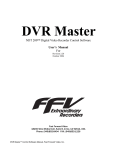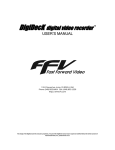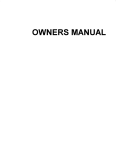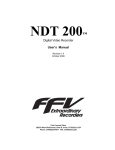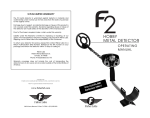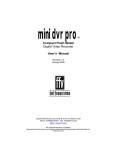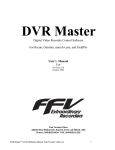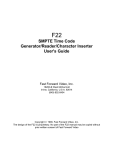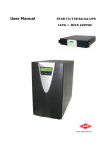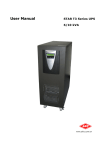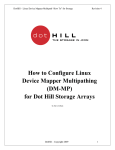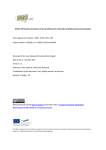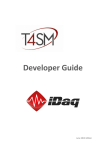Download OMEGA DECK - BroadcastStore.com
Transcript
OMEGA DECK Digital Video Recorder USER’S MANUAL 18200 West McDurmott, Suite B, Irvine, CA 92614, USA Phone: (949)852-8404 FAX: (949)852-1226 http://www.ffv.com The design of the Omega Deck and Omega Deck Manual is proprietary. No part of the Omega Deck may be copied or modified without the written consent of Fast Forward Video, Inc., printed in the U.S.A. MAINTENANCE Precautions The Omega Deck has been built to meet the demands of a studio environment, however, the hardware is subject to the same dangers from static as any other electronic device. Use care when connecting or disconnecting cables. IMPORTANT: Take care not to introduce any moisture into the unit. Electronic assemblies are sensitive to static electricity, due to the electrostatically sensitive devices used within the circuitry. All semiconductors, as well as some resistors and capacitors, may be damaged or degraded by exposure to static electricity. The hard drives and the video card must receive adequate ventilation, and be kept as cool as possible. We have designed a bracket with fans, already installed into each Omega Deck. This device will help prevent over heating of the drive and the video card. Overheating will most likely cause the unit to malfunction and possibly damage the video card. If you experience any problems with the unit please call Fast Forward Video’s service department. DO NOT ATTEMPT to repair or modify the unit as this might cause further damage, which could void your warranty. A technician can decipher whether your problem is caused by a faulty component, and determine whether you need to return it for evaluation and/or repair. Cleaning The chassis should only require dusting with a soft cloth. Solvents may harm the painted surface and leak to the inside causing severe damage. If you work in a dusty environment, periodic dusting within the unit using forced air is recommended to ensure the life of the fan and power supply. Operation and Storage Environment Due to the nature of the SCSI hard drives used with this device THE UNIT MUST BE USED IN A WELL VENTILATED AREA. Do not cover or block the ventilation area and try to avoid areas with excessive heat, which may cause the video card to malfunction. PACKAGE CONTENTS (May vary depending on model) 1 RS-232/422 Converter (KEEP IT HANDY FOR FIRMWARE UPDATES) Used to up-load the latest versions of the firmware to the deck, using your computer and a terminal emulation program (please refer to software update procedure on page 8 for instructions). The RS232/422 is also required if you are planning to control the Omega Deck via the RS-422 port also for using the control software. 1 POWER CABLE a standard 3-pin power cable. 1 SET of RACK EARS and 4 screws. The Omega Deck is rack mountable. 1-2 68 PIN SCSI TERMINATOR one per channel, (for non-removable drive version of Omega Decks). 1 CONTROL SOFTWARE CD 1 TROUBLE SHOOTING GUIDE and BASIC MENU SETTINGS laminated sheets 1 PACK OF ASSORTED HARD DRIVE SCREWS. (One free per order) If hard drives were ordered or dropped shipped to us they will come already installed in the unit and tested. Optional Serial Digital Interface cards or Extended Memory cards will also be installed in the unit. PLEASE RETAIN THE ORIGINAL SHIPPING CARTON AND FOAM If you need to return the unit for service or upgrade it is STRONGLY recommended that you use the original carton and foam, which were specifically designed to protect it from damage while in transit. IF RETURNED IN SOMETHING OTHER THAN ORIGIANL PACKAGING, A $30.00 FEE WILL BE ASSESED FOR THE USE OF NEW SHIPPING MATERIALS WHEN RETURNED BACK TO YOU. A PROTECTIVE METAL SHIPPING CASE IS ACCEPTABLE. FCC information to the user This device complies with part 15 of the FCC rules. Operation is subject to the following two conditions: (1) This device may not cause harmful interference, and (2). This device must accept any interference received, including interference that may cause undesired operation. This equipment has been tested and found to comply with the limits for a class a digital device, pursuant to part 15 of the FCC rules. These limits are designed to provide reasonable protection against harmful interference when the equipment is operated in a commercial environment. This equipment generates, uses, and can radiate radio frequency energy and, if not installed and used in accordance with the instruction manual, may cause harmful interference to radio communications. Operation of this equipment in a residential area is likely to cause harmful interference, in which case, the user will be required to correct the interference at his own expense. Omega Deck Manual, Fast Forward Video, Inc. – Revised 1/06/04 2 TABLE OF CONTENTS 1 Overview 4 2 Rear Panel Description 5 3 Hard Drive Installation and Formatting Procedure 4 Firmware Updating Procedure 8 5 Front Panel Buttons and Functions 9 6 Main Display 10 7 Native Mode Versus BVW-75 Mode 11 8 Main Menu 12 6-7 8-1 SETTINGS MENU 12 8-2 RECORD MENU 13 8-3 PLAYBACK MENU 14 8-4 PLAYLIST MENU 15 8-5 PLAYLIST MENU FUNCTIONS 16 9 TECHNICAL SPECIFICATIONS 10 OMEGA DECK CONTROLLER SOFTWARE 11 LIMITED WARRANTY Omega Deck Manual, Fast Forward Video, Inc. – Revised 1/06/04 17 18-22 23 3 1 OVERVIEW The Omega Deck series of digital recorders combines the industry's best image quality with a comprehensive feature set and a comparatively low price, which is the hallmark of Fast Forward Video's products. The Omega Deck digital recorder is also designed to develop and evolve as the industry changes. New features are implemented regularly, most of which can be easily implemented by the deck’s firmware, down-loadable via FFV's Web site, http://www.ffv.com (see page 8 for instructions). Because of this, the Omega Deck series will NEVER become obsolete. FEATURES • YUV Analog Component (Y, R-Y, B-Y) and Composite Inputs and Outputs • 60 fld/sec, 30 frm/sec NTSC or 50 fld/sec, 25 frm/sec PAL • Motion JPEG Compression Settings as low as 4:1 • Internally Maintains the Digital Video Industry Standard CCIR 601, 4:2:2 Format • Two Channels of Balanced CD Quality Audio Per Video Channel • Genlock Input Locks Analog Output to External Sync • SONY/SMPTE RS-422 Protocol with Odetics Broadcast Extensions • SMPTE/EBU Longitudinal (LTC) • SCSI II Fast and Wide Disk Controller • Front Panel Controls with LCD Touch-Screen OPTIONS • Serial Digital Interface (4:2:2 SMPTE 259 M-C, 270 Mbps) • Extended memory module for record time of up to 30 hours DUAL DECK FEATURES (IN ADDITION TO THOSE LISTED ABOVE) • Two independent video channels, each with two channels of balanced audio, and independent I/O for dedicated storage and RS-422 Machine Control. Each channel can be operated independently or simultaneously • Separate Control on the LCD Front Panel for each Channel RAID DECK FEATURES (IN ADDITION TO THOSE LISTED ABOVE) • Built in RAID Controller • Compression Ratios as low as 4:1. • Recording on one channel with simultaneous playback on the other Channel. Omega Deck Manual, Fast Forward Video, Inc. – Revised 1/06/04 4 2 REAR PANEL DESCRIPTION Rear Panel Illustration (Single Shown) 1 1 CHANNEL 1 - INPUTS TIME CODE 5 CH1 IN AUDIO 1 COMPOSITE Y R-Y OUT AUDIO 2 B-Y 2 3 OUT OUTPUT REF RS-422 OUT 6 Channel 1 SCSI 2 4 IN IN 7 1. ANALOG VIDEO INPUTS - Composite and Component (Y, R-Y, B-Y) input BNC connectors. 2. ANALOG VIDEO OUTPUTS - Composite and Component (Y, R-Y, B-Y) output BNC connectors. 3. RS-422 - MACHINE CONTROL (DB9 CONNECTOR) - This connector is for controlling the Omega Deck from an external RS-422 device or via PC (utilizing supplied RS-232 to RS-422 adapter). 4. SCSI II - This connector is for adding external drives to the Omega Decks internal SCSI drive chain. If an external device is not used than a terminator should be connected here (no external terminator ever required for removable drive version of Omega Deck). 5. TIME CODE IN AND OUT - RCA connectors for longitudinal time code (LTC). 6. AUDIO INPUT AND OUTPUT - Balanced audio XLR connectors. 7. REFERENCE BNC - Use this connector for genlock. The signal must conform to broadcast specifications which is RS-170 for NTSC. Composite video or black burst are acceptable. DO NOT connect nonstandard signals to the Omega Deck, or the picture WILL distort. 8. SDI- In the case of SDI, the IN/OUT connectors would take the place (spacing) of the three component inputs. In this configuration, the deck will set up with composite in/out, SDI in/out, and component out. Rear Panel Illustration (Dual Shown) 2 Omega Deck Manual, Fast Forward Video, Inc. – Revised 1/06/04 5 3 Drive Installation and Formatting Procedure For SCSI and SCA Models WE RECOMMEND That you have the drives installed, formatted and tested by Fast Forward Video. However, you may install the drives by following the procedure below. We ONLY recommend Seagate Cheetah Hard Drives LW series (LC for removable version of Omega Deck), which have been tested with the Omega Deck, and proven to have the best performance and reliability. SCSI DRIVE INSTALLATION PROCEDURE 1.) Unplug the unit and remove the 6 black screws from the chassis lid (three on each side of the deck). 2.) The bracket covering the video card is the bracket for the hard drive, it can hold one (1) or two (2) hard drives and has (2) screws holding it from the bottom of the chassis and three (3) from the right side of the deck. 3.) Remove the bracket and fasten the hard drive(s) using four # 6 x 32 x 1/4” pan head screws (supplied). Make sure that the SCSI interface is facing to the center of the Omega Deck, and there is clearance (approximately 1/4 inch) between the hard drive and the fan assembly. 4.) After mounting the hard drive to the bracket, re-install bracket back into chassis. If installing into a Dual Deck, make sure that you don’t pinch the video card connected to channel two or any of the nearby cables. Re-install the five screws that hold the mounting bracket (lock washer screws go on the bottom of the chassis). 5.) Plug the SCSI II cable into the connector of the hard drive and hook up the four pin power Molex connector from the Omega Deck’s power supply. If the drive is the second in the chain, i.e. the second drive on the same channel, make sure it’s address ID is set to “1” (the first drive should be ID “0“). 6.) Replace the chassis lid using the 6 black screws (4/40 x ¼” flat head). Switch the unit on, wait for it to bootup and proceed to format the hard drive. SCSI DRIVE FORMATTING PROCEDURE SCSI ID JUMPERS: Each device on the SCSI chain must have a unique SCSI ID. ID “0” is lowest priority in a 16-bit system. Most Cheetah disc drives are factory set with the SCSI ID set at “0“. To change the SCSI ID, refer to the label on the hard drive. If you are installing drives into an Omega Dual Deck, each channel must be considered independent of the other. Therefore, the first drive connected to channel one should be set to ID “0” and the first drive connected to channel two should be set to ID “0”. These are default IDs and no jumper is needed. DRIVE TERMINATION: Termination is required only for the standard version of the Omega Deck not for the “removable drive” version. FORMATTING THE HARD DRIVE: Most SCSI hard disks come with a "low-level" format from the manufacturer. However, the disk will still need to be formatted for the Omega Deck so that the video data files created by the Omega Deck, are stored properly. This is done by simply clearing the disk through the clear disk menu of the Omega Deck. Omega Deck Manual, Fast Forward Video, Inc. – Revised 1/06/04 6 Hard Drive Installation and Formatting Procedure For SCSI and SCA Models (Continued) Omega Deck Split Front Panel, Hot Swap Hard Drive Version SCA DRIVE INSTALLATION, REMOVAL, AND REPLACEMENT PROCEDURE NOTE: The Omega Deck accepts from 9 GB, to 73 GB Seagate Cheetah drives with an SCA connector (80 pin). Be sure to specify Seagate’s LC Series when adding or replacing drives. For example, an 18 Gig model number would be ST318406LC. For any questions regarding recommended hard drives, please contact [email protected]. REMOVAL 1.) Open the front panel door by rotating the ¼ turn knob counter-clockwise on the lower left corner of the door. 2.) Each tray has a hand actuated panel fastener on the right side of the front lip. To REMOVE, rotate knobscrew counterclockwise until the fastening screw clears the hard disk cage anchor, grasp the disk tray by the upturned flange on the lower left side and pull the tray straight out from the cage. 3.) Remove the two mounting screws (#6 x 32 x ¼” flat head) from the bottom of the drive tray. Hold the tray in the palm of one hand and using the thumb and fingers of the opposite hand, lift the front edge upward and remove the hard disk from the tray. REPLACEMENT 1.) Hold the tray in the palm of one hand and using the thumb and fingers of the opposite hand, slip the rear of the Hard Disk against the inside edge of the front lip and tilt the front end of the hard disk down toward the tray until the alignment pins slip inside the threaded mounting holes on the drive. 2.) To re-insert drive/plate assembly into the cage, lay the front edge of the tray against the lip edge of the selected slot, hold the tray parallel to the internal guides and gently push in until you feel that the connectors have seated. Secure the drive in place by rotating the knob clockwise until it is fully locked. (NOTE: The front door will not close completely if the knob-screw is not fully seated). Close the front door and rotate the ¼ turn knob clockwise until it stops. As with any new drive on any Omega Deck, formatting the drive will be necessary. Again, this is done by clearing the disk from the disk menu on the touch screen. Omega Deck Manual, Fast Forward Video, Inc. – Revised 1/06/04 7 4 Updating Firmware New features for the Omega Deck are posted to our website as they become available. Our customers have access to these features via firmware updates for the lifetime of the product. Please check this site regularly to implement the newest changes. Firmware updates are located at www.ffv.com in the Support sub directory. Locate the latest revision of firmware for the front panel ( fpo.fud for single channel decks, or fpdual.fud for two channel decks) and the video board (G4xx.fud). Please note that the dates may not be the same for the front panel and video board firmware. Download and unzip the files. Hook up the Omega Deck to your computer: Hook a DB9 straight through cable to the RS 422 port located on the back panel of the Omega Deck. Hook up the 232 side of the RS-232/422 converter to the 9 pin serial port of your computer. Note: if using a slow motion controller you will only need the straight through cable. Hyper Terminal Set-up: On your host computer, open up the Hyper Terminal folder from the Start Menu, there should be an icon for setting up a new control called Hypertrm. 1. CONNECTION DESCRIPTION: FFV, choose an Icon, OK 2. PHONE NUMBER: Enter any phone number, choose a communication device, OK 3. CONNECT: Cancel 4. CONFIGURE /CONNECTION / CONNECTION PREFERENCES: DATA BITS: 8 5. PARITY: ODD STOP BITS: 2 FLOW CONTROL: NONE FILE / PROPERTIES / SETTINGS: FUNCTION: terminal keys, EMULATION: ANSI, BACKSCROLL BUFFER LINES: 500 IMPORTANT: YOU MUST LOAD THE FIRMWARE IN THE FOLLOWING ORDER!! 1. FIRST UPLOAD ( fpo.fud or fpdual.fud) TO THE FRONT PANEL ( FOLLOW PROCEDURE BELOW); 2. UPLOAD (G4XX.fud) TO THE VIDEO CARD ON CHANNEL ONE, REBOOT 3. UPLOAD (G4XX.fud) TO THE VIDEO CARD ON CHANNEL TWO (For Dual or RAID units) Sending the Firmware to the Omega Deck 1. On the front panel of the Omega single channel Deck, touch the question mark for the firmware data screen. On Dual Decks, you must go through the main menu, firmware submenu. 2. Touch the box labeled UPDATE AT 38400, the Omega Deck will send a message to your computer: Begin your CRC Xmodem transfer now: locate the file by clicking on browse and send it, when it has been transferred you will receive the message: successful completion. 3. TURN OFF the Omega Deck, wait a moment, TURN ON the Omega Deck, allow it to boot up completely. Omega Deck Manual, Fast Forward Video, Inc. – Revised 1/06/04 8 5 Front Panel Buttons and Functions POWER SWITCH: Turns the unit on / off. Please allow at least 30 seconds after turning the unit on for it to bootup and recognize the disk. IMPORTANT: IF YOU ARE USING EXTERNAL HARD DRIVES YOU MUST TURN ON THE Omega Deck FIRST AND ALLOW IT TO WARM UP FOR A FEW SECONDS THEN TURN ON THE DRIVES. PASS-THRU: The red LED above the record button will light up indicating that it is in digital pass-thru mode, which indicates it is record ready. A corresponding message will be displayed in the mode indicator area located in the center of the LCD touch-screen panel. RECORD 1. PRESS THE RECORD BUTTON, HOLD, PRESS THE PLAY BUTTON. 2. PRESS STOP TO END THE RECORD SESSION. A RECORD message should appear in the mode indicator display and the time code display will show that video data is being recorded onto the storage media. RECORDING IN NATIVE MODE: Recording in native mode will place the recorded material in the next available free space on the disk. Native mode will not allow you to record over previously recorded or existing material. An error message will appear indicating that the disk is full when all available space has been used at which time you will need to clear the disk to record. RECORDING IN BVW-75 MODE: Recording in BVW-75 mode will allow you to record anywhere on the disk regardless of whether or not it has previously recorded material. You can begin recording by cueing to the point you wish to begin and pressing stop to end the recording. PLAY: To PLAY from the beginning, press the “<<” button (notice that in NATIVE mode, it is instantaneous, no waiting for tape to shuttle back). The time code display will indicate that you are at 00:00:00:00 and the reference monitor hooked up to the Omega Deck will jump to the beginning of the disks recorded video material. Press the play button to view the recorded video material. In BVW-75, the “<<” will rewind to the beginning of the hard drive at 30X speed. STOP: Terminates both the play and record functions but will not clear the screen. CHASE LOCK: To enable this feature, simply press and hold the PLAY and STOP buttons simultaneously for 2 seconds. If feeding time code into the Omega Deck, that channel will lock to the incoming time code during playback. SHUTTLE / SCAN SELECT: This allows you to choose between a variety of noise-free slow motion speeds as well as fast motion scans. 1. Press this button to select the corresponding LED to change modes. The orange light places Omega Deck in scan mode and the green light in slow motion. 2. Once you have selected the desired mode use the forward and reverse buttons located to the left and right of the select button. STEP BACK <: Press to step the Omega Deck backward one frame. Each subsequent press equals one frame. STEP FORWARD >: Press to step the Omega Deck forward one frame. REWIND (START POINT): Press to jump back to the first frame of a selected clip. Press and hold to jump back to the first frame of video on the hard drive. FAST FORWARD (END POINT): Press to jump forward to the last frame of a clip. Press and hold to jump to the last frame of video on the hard drive. JOG / SHUTTLE WHEEL: Similar to a traditional analog tape deck, this wheel acts and feels the same. In addition to machine control, this wheel is also used for selecting various options in some of the menus accessed from the front panel's touch screen. Omega Deck Manual, Fast Forward Video, Inc. – Revised 1/06/04 9 6 Main Display Front Panel LCD Display 3 8 S Dual Channel LCD Display 4 s p An LCD touch-screen panel (illustrated above) with a menu of options and a variety of parameters used to operate the Omega Deck’s functions. To lock both channels together for simultaneous control, simply touch both channels at the bottom of the LCD display at the same time, until they are both highlighted. 1. TIME CODE DISPLAY Displays the assigned Time Code for the frame in use. 2. MODE INDICATOR The current transport mode will be displayed directly above the Time Code in the center of the touch screen, such as: RECORD, PASS-THRU, PLAY, REV 1/3, FWD 3x, STOP, etc. 3. DISK CAPACITY INDICATOR This icon is located on the top right of the touch screen and displays the percentage of disk space used. 4. FIRMWARE ICON? Appears as a question mark in the upper left hand corner of the screen of single channel decks. Pressing this icon will reveal the version of firmware currently running. NOTE: To access the firmware on a dual deck, you will have to go through the main menu, and select the FIRMWARE sub menu. 5. MENU ICON The menu icon appears as a tiny rectangle at the top of the screen, this is where you will find most of the main functions for the Omega Deck. These functions allow the operator access to Omega Deck’s menu structure and system settings and are explained in detail on the following pages. 6. GO TO ICON Select the “GO TO” function to mark one frame of video to jump back to immediately upon request. You can store only one selection at a time. 7. HOME ICON This Omega Deck symbol is the home icon located in the upper right hand corner of each screen (except main display). Pressing the home icon will return you to the main display from any other screen (see page 12, sec. 8). 8. “S” OR “P” Indicates weather deck is currently in a Source list (S) or a Playlist (P) A letter ‘S’ in the bottom right corner of the touch screen indicates that you are playing back material from the source list. A ‘P’ indicates that you are working out of a playlist. Omega Deck Manual, Fast Forward Video, Inc. – Revised 1/06/04 10 7 Native Mode Versus BVW-75 Mode The Omega Deck was conceived to replace analog tape decks and therefore, has some of the features associated with them. However, this is where the similarity ends. The Omega Deck is capable of far more functions than tape decks, which will become apparent with operation. The critical distinction between the Omega Deck and a Video Tape Recorder (VTR) is the ability of the Omega Deck to operate in a native or non-linear mode. NATIVE MODE Native mode is the most natural state for the Omega Deck to operate in as it utilizes the random access capabilities of the hardware most effectively. As you record material to the Omega Deck it stores the material in the available space on the storage media. When it gets to the time code point you have selected for the inserted material, it jumps to that point on the drive--wherever that may be--plays it, then returns to the original section. Note: Playlist functionality is only available in native mode BVW-75 MODE Linear mode is a simulation of an existing VTR. The Omega Deck, in linear mode, is forced to adhere to strict record guidelines as if it actually were a tape deck. If you would like to operate the Omega Deck as a VTR, make sure you have selected BVW-75 mode from the SETTINGS menu, PERSONALITY sub menu of the front panel. You can then record over existing material as you would with a VTR. The main feature of this mode is the ability to insert edit material over previously recorded material. The Omega Deck, in BVW-75 mode assumes that it has a 24 hour tape of “black” attached to itself which has time code assigned from 00:00:00:00. If you were to tell the Omega Deck to record a 10 second clip at 00:01:00:00 for 10 seconds, it would record this and the machine would then assume it had 1 minute of black, 10 seconds of video from the 1 minute time code mark, and then 23:58:50:00 of black after this. If you want to record over this clip and add new information, it will insert the video at the same points and overwrite the data on the drive in the same way, always maintaining the 24 hours of time code as the master reference. Note: Playlist functionality is NOT available in BVW-75 mode. IMPORTANT NOTE: If you record material in BVW-75 mode, the Omega Deck uses the 24-hour time code as reference, which is still visible to the machine when you switch to native mode. However, when you record material in native mode and then switch to BVW-75 mode the machine does not recognize the native source list. You should always record in BVW75 mode if you intend to switch between personalities. Omega Deck Manual, Fast Forward Video, Inc. – Revised 1/06/04 11 8. Ma i n Me n u To access the menu and adjust any of the settings on the Omega Deck, simply touch the menu icon located in the upper right side of the touch screen (on single channel decks), it appears as a small rectangle with tiny lines. For dual decks, touch the disc capacity indicator to access the main menu. Each of the choices listed on the main menu have sub-menus. Following the illustration are detailed descriptions of the functions accessed through the Menu Icon. Main Menu Display 5 Home Icon 8-1 Settings Menu Settings Menu Display 6 Y, R-Y, B-Y NATIVE PERSONALITY NATIVE OUTPUT RECOVER UNDERRUN RECOVER NTSC STANDARD NTSC Y, R-Y, B-Y TIME CODE TIME CODE FRONT PANEL FRONT PANEL PERSONALITY Using this command, you can select among Native Mode, which uses Odetics extensions in the RS-422 protocol, BVW-75, which equates to a Sony BVW 75 protocol, and Time Delay ON or OFF, which is used only in RAID decks. Note: If you want to use BVW-75 Mode, you must use this for record and play back. If you record in Native Mode, your material will not be available to you when you switch to BVW-75 Mode as the information in Native Mode is all related to a record index. UNDERRUN Should be set to RECOVER. In this mode, the deck will continue to record in the event that frames are dropping. If set in STOP, the deck will automatically stop recording if it encounters bad frames. STANDARD The Omega deck can be configured to play either NTSC (National Television Standards Committee) video, which is 525 lines and 30 frames or 60 fields per second, or PAL (Phase Alternate Line) video which is 625 lines and 25 frames or 50 fields per second. OUTPUT Allows for switching outputs between Y, R-Y, B-Y (component), or RGB. TIME CODE Allows for switching of time code input between Non-Drop frame, and Drop-Frame. FRONT PANEL This sub menu allows you to access the front panel’s brightness/contrast setting capability, and to disable the front panel controls for uninterrupted recording or playing. Omega Deck Manual, Fast Forward Video, Inc. – Revised 1/06/04 12 8 -2 Record Menu Record Menu Display 7 COMPRESSION LEVEL The M-JPEG compression settings on all versions of the Omega Deck are user selectable from 4:1 to 20:1. In practice, it is advisable to set the compression to correspond with the best quality to storage ratio. A setting of 7:1 is a good setting for general purpose Betacam images, 1O: 1 for S-VHS, 15:1 for VHS. Use the UP and DOWN arrows to scroll through the levels and choose the desired setting. MIN. PER GB: This screen gives you a basic reading of the minutes of storage generally available with the corresponding compression setting. The frames are dynamically quantified, which means that if you set the Omega Deck at 5:1 it may record some frames at 4:1 and less complex ones at 8:1 but will maintain an image quality level of approximately 5:1. TOTAL TIME: This number relates to the amount of time available for recording, based on the approximate minutes per gigabyte and the amount or size of the storage media. TIME LEFT: As above, this figure will give a quick reading of approximately how much time is left for recording. INPUT Allows you to select Component I/O or Composite I/O (or DIGITAL if equipped with SDI). SINGLE FRAME Enable single frame to record a single frame at a time. LOOP RECORD This function allows you to continuously record material to the hard drive. Once the drive is full, the process starts again at the beginning of that clip by recording over the previous material. Except in a case where there is already video on the hard drive, and loop record is activated, then only the subsequent recording will loop. It will not override what has already been recorded. Note: The empty space next to the word Record is a hidden menu to switch the pass through from digital to analog. Omega Deck Manual, Fast Forward Video, Inc. – Revised 1/06/04 13 8 -3 Playback Menu Playback Menu Main Display 8 SLOW MOTION This allows you to define the clarity of the image to suit your needs. If you select frame mode in slow motion play back and stop on a single frame, it may appear jerky as the Omega Deck switches between the two fields of the frame. If you now select field, the image will stop moving albeit you will only see half the horizontal lines of resolution. LOOP PLAY Allows you to play a segment of designated video in Loop mode, endlessly. Be sure to enable loop play under the playback menu. Play Speed Allows you to select the desired speed for playback. 1. Push the square next to the play speed choice on the playback menu; 2. Use the up and down arrows to select the desired speed; 3. Push OK when your selection is displayed. To return to the default 1/1 (30 frames per second) quickly, just press the square. Genlock Genlock can be enabled to use with an external or internal generator. The internal Genlock will lock to the time code of the recorded video. You can also lock channel 2 to channel 1 when using the RAID deck to allow accurate replay from the same source material. H Sync Pos and S C Phase H SYNC POS: Allows you to set the H sync position and adjust the horizontal timing of the reference signal. S C PHASE: Allows you to set the sub carrier phase and adjust the timing of the color signal. Push SET and the following option screen appears: Set the timing by turning the knob to the left for lead or to the right for lag; PUSH OK Disk Menu Select disk from the main menu to format or clear the disk. You can also delete clips from the source list and playlists. Copy disk is available only in single channel Omega Decks. Omega Deck Manual, Fast Forward Video, Inc. – Revised 1/06/04 14 8.4 Playlist Menu The Playlist option is only available if you are using native mode. RECORDING CLIPS: Record the desired material either as one clip or as many individual clips. Each time you begin and end a recording, a new clip will be added to the source list. The clips will be listed as untitled clips in the sourcelist with the length of the clip to the right of it. PLAY LIST: To access the playlist function menu, touch the line which runs along the bottom portion of the touch panel's main display, or by selecting edit from the main menu. SOURCE LIST: Once you have finished recording, press stop. To access the source list, touch the line located at the bottom of the main display or select edit from the main menu (you must be in STOP mode to access the source list). There should be a list of untitled clips in the sourcelist based on the material just recorded. By default, they are named CLIP 0000, CLIP 0001, ETC. Choose a clip by turning the knob and highlighting your selection. You may name the clips in your source list if you wish or you can name them after they are added to the play list. The source list contains all the originally recorded material. You can add clips to the play list while always keeping the original clip in your source list (unless you delete it). TRIM: The trim function is for editing the original clips after they have been added to the play list. Below is an illustration of the trim screen, which appears when you select trim from the play list window. Specific features and their functions are briefly outlined below the illustration 3 2 4 5 1 1. IN AND OUT BUTTONS: used to designate the beginning and ending of a clip. 2. SCRUB BAR: Scrolling indicator. 3. ZOOM: (Not shown) allows you to scroll through the clip faster. 4. SOURCE LIST CLIP: Indicates the number of the clip currently in use under trim mode. 5. FRAME: Indicates the number of the frame in use as you scroll through the material with the scrub bar. Omega Deck Manual, Fast Forward Video, Inc. – Revised 1/06/04 15 8.5 Playlist Menu Functions TRIMMING THE CLIP You may review the clip by pressing play, turning the knob, or using the step forward/back buttons. Select the desired start point by pressing the IN button and the end point by pressing the OUT button. Note that the thick dark line in the middle of the screen is now a shorter line, which indicates the size of the clip you have just created. If you have a large clip and wish to scroll through it quicker you can use the zoom feature located at the top of the screen near the upper left corner of the window. NAMING YOUR PLAYLIST You may name each clip in your source list and / or your play list by highlighting the selection, then pressing name. There are two screens for naming clips as shown below; you may designate up-to 32 characters per clip. Note the box in the left corner of the playlist screen with the words untitled playlist. Touch the box and the screen changes to the naming screen, the words “untitled playlist” have moved but are still contained in a box. Touch the box again and it will clear then type in the new name. Be sure to save your changes before turning off the unit. (See saving playlist, below) Touch to move to the right screen Touch to move to the left screen SAVING A PLAYLIST: When you add to, change, or rename your playlist, you need to save it. To save your playlist, select playlist from the main menu, notice the word SAVE is highlighted, press it and the playlist is saved. AUTOMATIC PLAYLIST LOAD: In the upper left portion of the playlist menu, there is a feature named a play load. With this feature, you can designate one playlist to automatically begin to play on power up, as soon as the hard drive is initialized. STORING MULTIPLE PLAYLISTS: If you wish to make a new playlist with another name, choose an existing playlist and remove all or part of the clips from it. You can make the necessary changes to the new playlist, re-name it and you now have multiple playlists to choose from. Once you have more than one playlist you must select playlist from the main menu and activate the one you wish to use by loading it. REMOVING CLIPS: If you want to delete clips from the playlist, highlight the selection and press REMOVE located at the top of the screen. DELETING A CLIP AND / OR A PLAYLIST: Select DISK from the main menu. CLEAR DISK: Used to clear the entire hard drive. DELETE CLIPS OR FRAMES: To delete clips contained in the source list. DELETE PLAYLIST: To delete a playlist. Omega Deck Manual, Fast Forward Video, Inc. – Revised 1/06/04 16 9. Specifications Dimension: Warranty: 3.5” H x 17” W x 14” D 1 Year VIDEO COMPRESSION Method: Compression Ratio: VIDEO INPUT Analog Input: Component (Y, R-Y, B-Y) and Levels: Standards: Composite 1.0Vp-p, 75 ohms 525/60 (NTSC) or 625/50 (PAL) VIDEO OUTPUT Analog Output: Horizontal Resolution: Levels: Standards: Connections: Balanced, XLR connectors Component (Y, R-Y,B-Y) RGB and Composite Greater than 550 TV lines (at AUDIO SPECIFICATIONS Resolution: 16 bits Channels: 2 in, 2 out 4:1 compression) 1.0Vp-p, 75 ohms 525/60 (NTSC) or 625/50 (PAL) BNC Dynamic Range: Harmonic Distortion: Output Impedance: Sampling Rate: Passband: Passband Ripple: VIDEO INPUT DECODER Format: Digital 4:2:2 YCrCb 60 fields per second NTSC, 50 fields per second PAL Digital Color Space: YUV Sampling: 13.5 MHz Pixel Resolution: 720 x 486 pixels (525/60), S/N Ratio: Bandwidth: Differential Gain: Differential Phase: AUDIO INPUT/OUTPUT Analog Input/Output: Motion-JPEG (Joint Photographic Experts Group) Variable down to 2:1. On most images, compression artifacts are ratios below 8:1. This is a subjective threshold. 720 x 576 pixels (625/50), 45 db 8 MHz (-3 db) 2% 2 deg. VIDEO OUTPUT ENCODER Digital Color Space: YUV, 16 bits per pixel Analog Bandwidth: Composite: 4.5 MHz (NTSC) 5.0 MHz (PAL) S/N Ratio: 60 db 80db 022%, -73 db 600 ohms 48 KHz .045 FS +/-0.1 db SCSI DISK CONTROLLERS Protocol: Ultra-2 SCSI Maximum Data Rate: Maximum Hard Drives: Supported Hard Drives: 40 MB/second 7 Contact Fast Forward Video COMMUNICATIONS INTERFACE RS-422 Interface: 38400 baud TIME CODE SMPTE / EBU Longitudinal (LTC) GENLOCK INPUT Level: RECOMMENDED HARD DRIVES. Seagate Cheetah SCSI 18-73Gb LW series 1.0Vp-p, 75 ohms Ultra 160/320 LC series for the removable drive version of Omega Deck. Omega Deck Manual, Fast Forward Video, Inc. – Revised 1/06/04 17 OMEGA DECK™ CONTROLLER SOFTWARE VERSION 3.3 18200 West McDurmott, Suite B, Irvine, CA 92614 (949) 852-8404 Fax: (949) 852-1226 http://www.ffv.com © FAST FORWARD VIDEO, INC. 2000 THE DESIGN OF THE OMEGA DECK™ IS PROPRIETARY. NO PART OF THE OMEGA DECK™ MAY BE COPIED OR MODIFIED WITHOUT THE PRIOR WRITTEN CONSENT OF FAST FORWARD VIDEO, INC. Omega Deck Manual, Fast Forward Video, Inc. – Revised 1/06/04 18 About the Omega Deck Controller Software The Omega Deck controller software turns your PC, running Windows 98, 98SE, Me, 2000, XP Home or XP Professional, into an RS-422 controller for the Fast Forward Video Omega Deck. The software also provides many enhancements and controls not available on the front panel, including easily recording, naming and logging of video clips, build, edit, & save playlists, set bookmarks (cue points) and playback of multiple playlists. Using the Software When the software starts up, it searches your PC’s serial ports for an Omega Deck. Once found the software will list all recorded video clips in the sourcelist window. Click on a clip name and press <Spacebar> or click the Play button to play the clip. • Use the <Up arrow> and <Down arrow> keys to jump to other clips. Use <Right arrow> and <Left arrow> to seek within a clip by one frame. • Press <Enter> or double-click on a clip in the sourcelist window to append it to a playlist. It will appear in the playlist window. • After you have some clips in a playlist, click on the playlist window to activate it. Press <Home> to rewind the playlist to the first frame, then press <Spacebar> to start playback. Basic playlist editing On the left side of the screen, the “Current in point” box contains the in-point for the current clip, as well as buttons for editing the in-point. On the right side of the screen, the “Current length” box contains similar controls for editing the length of the clip. In both of these boxes: “Mark” saves the current frame as the in-point or length “Set” allows you to type in a number to use as the in-point or length. It also allows you to increment/decrement the hours, minutes, seconds or frames. “Go to” jumps to the in-point or out-point of the current clip. “Clear” makes available all frames of the clip from the current in/out point to the first/last frame of the clip. When you have edited a clip in the playlist the “CURRENT CLIP POSITION” timeline will turn all unused head and tail frames yellow. This provides you a quick visual reference to the length of a clip you have not used. • • To move a playlist entry to another position in the list, hold down the <Ctrl> key, then click and drag an entry. To copy an entry, hold down both <Ctrl> and <Alt> then click and drag to it’s new location. Recording video 1. In the sourcelist window, click the “Recording” tab. The Omega Deck goes into “Pass through” mode, and is ready to record video and audio. 2. Press <Enter> or click the “Record” button to start recording. 3. Press <Enter> or click “Stop rec” to end recording. When you stop recording, whatever clip description and notes you have entered will be saved with the clip and the clip will show up in the sourcelist window. 4. Click the “Playback” tab to cue up your last recorded clip. Press <Spacebar> to playback. 5. The “Options” button will open a window allowing you to set recording compression parameters and choose video inputs. Omega Deck Manual, Fast Forward Video, Inc. – Revised 1/06/04 19 Installation Requirements RS-232 to RS-422 converter (one came with your Omega Deck) 9-pin male-to-male serial cable (your computer’s available connector may vary) Minimum system PC running Microsoft Windows 95, 98, 98SE, or NT 4.0 800x600 screen resolution, 256 colors 750 MHz processor 128 MB RAM How to hook up the deck to the computer 1. Power on the Omega Deck. 2. Plug the RS-232 side of the converter into your PC’s serial port. 3. Plug one end of the serial cable into the RS-422 side of the converter; plug the other end into your Omega Deck. The software automatically searches through your serial ports for an Omega Deck; you don’t need to worry about what port you put it on. The software also sets up the communications parameters for the port. Just attach the deck to your PC and you’re set. If the software doesn’t find your Omega Deck, even though you have it hooked up and powered on, please check the following two items: make sure you have the side of the converter labeled “RS-232” plugged into your computer, and make sure that your serial cable is a “straight-through” cable – not a “null-modem” cable. When you are finished with your current session it is recommended that you close the Omega Deck Controller software before disconnecting or turning off the Omega Deck. Installing the controller software Insert the CD-ROM into your computer’s CD-ROM drive. The installation program may start automatically. If it doesn’t, click on “Start”, “Run”, and type “X:\setup.exe” (without the quotes), where X is the drive letter of your CD-ROM drive. When the setup program has finished, click on “Start” / “Programs” / “Omega controller” / “Omega controller” to run the software. Omega Deck Manual, Fast Forward Video, Inc. – Revised 1/06/04 20 Bookmark limits There is no limit to the number of bookmarks you may have, except that there can only be one bookmark per frame. Speed changes at bookmarks When the deck plays past a bookmark set with a speed change, it will change the deck to the new speed. Remember, this is a one-way change. Your original speed will not later be restored automatically. Tip: Set a bookmark with your original speed at the beginning of the playlist, so whenever you recue, you’ll restore your desired starting speed. Speed ramps at bookmarks Instead of setting an abrupt speed change at a bookmark, you may set a speed ramp between two bookmarks. Set the first bookmark as “Begin ramp”, and give it your initial speed. Set the second bookmark as “End ramp”, and set the terminal speed. The software will gradually ramp from the first speed to the last speed between the bookmarks. Remember, this is a one-way change. Your original speed will not later be restored automatically. Tip: Set a bookmark with your original speed at the beginning of the playlist, so whenever you recue, you’ll restore your desired starting speed. Changing bookmark location While you cannot drag a bookmark to a new location, you can right-click on it and select “Change location.” Features Insert source clip / add source clip (playlist) If you right-click on a playlist entry, the first two menu items that appear are “Insert source clip” and “Add source clip.” These will both show you the names of all clips in the current source folder. Selecting a clip will either insert it before or add it after the current entry. With these two menu items, you can avoid switching to the sourcelist window to add another clip to your playlist. Split clip (playlist) Splits the current clip into two clips; the current frame becomes the out-point of the first clip, and the next frame becomes the in-point of the new clip. Auto split clip (playlist) In a playlist entry with multiple bookmarks, auto split clip will split the clip at each bookmark. Generic bookmarks Ctrl+B will allow you to drop a bookmark at the current frame, while recording or playing back, in the playlist or sourcelist. Bookmark navigation Tab and shift+tab will jump you to the next and previous bookmark. This is great for sports instantreplay uses – drop a bookmark during record, whenever there’s interesting action, and instantly jump to it on playback. Then hit Tab, and jump to the next bookmark. Bookmarks on the timeline Left-clicking on a bookmark will jump to it. Right-clicking on a bookmark pulls up a properties menu that allows you to set the name, hotkey, speed, and whether it’s the beginning or end of a speed ramp. Omega Deck Manual, Fast Forward Video, Inc. – Revised 1/06/04 21 Keyboard Shortcuts Spacebar Toggle play/pause Ctrl+Alt+Right Seek forward five second Left arrow Seek backwards one frame Up arrow Seek to the head of the previous clip in the list Ctrl+Left Seek backwards one second Down arrow Seek to the head of the next clip in the list Ctrl+Alt+Left Seek backwards five seconds Home Jump to first clip in list Right arrow Seek forward one frame End Jump to last clip in list Ctrl+Right Seek forward one second Ctrl+Up Seek to the head of the current clip Ctrl+Shift+Up Select first deck F6 Mark out point Ctrl+Shift+Down Select last deck Ctrl+F6 Split clip at current frame Ctrl+Shift+Left Select previous numbered deck F7 Set out point Ctrl+Shift+Right Select next numbered deck F8 Go to out point Delete Remove clip from playlist F9 Clear out point Ctrl+G Go to offset within current playlist F10 Turn on shuttle mode Ctrl+Alt+G Go to offset within current clip ESC Turn off shuttle mode F1 Mark in point Ctrl+N Rename current clip F2 Set in point Ctrl+L Toggle loop current clip F3 Go to in point Ctrl+W Toggle pause at end of clip F4 Clear in point Ctrl+N Rename current clip Enter (playback mode) Enter (record mode) Append current source entry to playlist Delete Permanently delete source clip from deck Toggle recording start/stop Ctrl+B Drop generic bookmark Ctrl+O Open playlist Tab Jump to next bookmark Ctrl+S Save playlist Shift+Tab Jump to previous bookmark Alt+Left Decrease playback speed Ctrl+Backspace Delete bookmark at current frame Alt+Right Increase playback speed Ctrl+1 thru 9 Drop numbered bookmark at current location Ctrl+A Activate playlist window 1 – 9, 0 Jump to numbered bookmark Ctrl+P Activate sourcelist playback window Ctrl+R Activate sourcelist record window Omega Deck Manual, Fast Forward Video, Inc. – Revised 1/06/04 22 W Waarrrraannttyy 12 – MONTH LIMITED WARRANTY Fast Forward Video, Inc. warrants to the original purchaser that the product (Hardware and components) shall be free from defects in material and workmanship for a period of 1 year from the date of purchase, If a defect covered by this warranty occurs during this 1 year period, Fast Forward Video, Inc. will repair or replace the defective product or component, at its option, free of charge. WARRANTY LIMITATIONS THIS WARRANTY SHALL NOT APPLY IF THIS PRODUCT: (a) IS DAMAGED BY NEGLIGENCE, ACCIDENT, MISUSE, OR BY OTHER CAUSES UNRELATED TO DEFECTIVE MATERIALS OR WORKMANSHIP; OR (b) HAS HAD THE SERIAL NUMBER ALTERED, DEFACED, OR REMOVED. ANY APPLICABLE IMPLIED WARRANTIES ARE HEREBY LIMITED IN DURATION TO THE WARRANTY PERIOD DESCRIBED ABOVE. IN NO EVENT SHALL FAST FORWARD VIDEO, INC. BE LIABLE FOR CONSEQUENTIAL OR INCIDENTAL DAMAGES RESULTING FROM THE BREACH OF ANY IMPLIED OR EXPRESS WARRANTIES. SOME STATES DO NOT ALLOW LIMITATIONS ON HOW LONG AN IMPLIED WARRANTY LASTS OR EXCLUSION OF CONSEQUENTIAL OR INCIDENTAL DAMAGES, SO THE ABOVE LIMITATIONS MAY NOT APPLY TO YOU. This warranty gives you specific legal rights and you may also have other rights which vary from state to state. Omega Deck Manual, Fast Forward Video, Inc. – Revised 1/06/04 23























